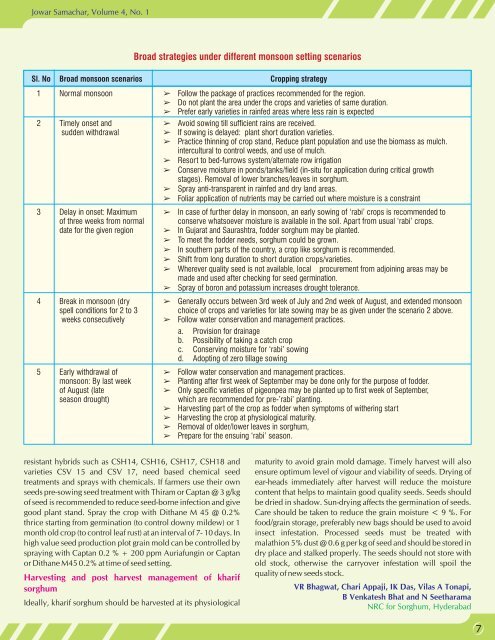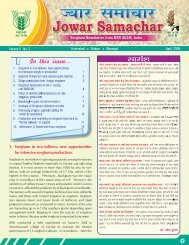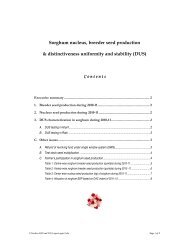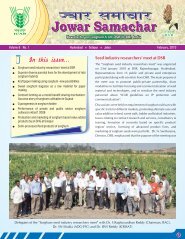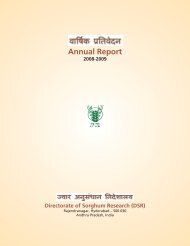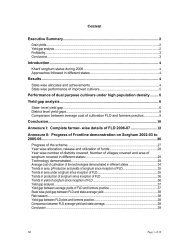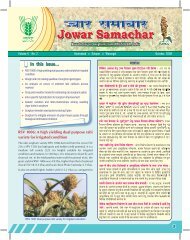Jowar Samachar NRCS CQ.cdr - Directorate of Sorghum Research
Jowar Samachar NRCS CQ.cdr - Directorate of Sorghum Research
Jowar Samachar NRCS CQ.cdr - Directorate of Sorghum Research
Create successful ePaper yourself
Turn your PDF publications into a flip-book with our unique Google optimized e-Paper software.
<strong>Jowar</strong> <strong>Samachar</strong>, Volume 4, No. 1<br />
Broad strategies under different monsoon setting scenarios<br />
Sl. No Broad monsoon scenarios Cropping strategy<br />
1 Normal monsoon ã Follow the package <strong>of</strong> practices recommended for the region.<br />
ã Do not plant the area under the crops and varieties <strong>of</strong> same duration.<br />
ã Prefer early varieties in rainfed areas where less rain is expected<br />
2 Timely onset and ã Avoid sowing till sufficient rains are received.<br />
sudden withdrawal<br />
ã If sowing is delayed: plant short duration varieties.<br />
ã Practice thinning <strong>of</strong> crop stand, Reduce plant population and use the biomass as mulch.<br />
intercultural<br />
to control weeds, and use <strong>of</strong> mulch.<br />
ã Resort to bed-furrows system/alternate row irrigation<br />
ã Conserve moisture in ponds/tanks/field (in-situ for application during critical growth<br />
stages). Removal <strong>of</strong> lower branches/leaves in sorghum.<br />
ã Spray anti-transparent in rainfed and dry land areas.<br />
ã Foliar application <strong>of</strong> nutrients may be carried out where moisture is a constraint<br />
3 Delay in onset: Maximum ã In case <strong>of</strong> further delay in monsoon, an early sowing <strong>of</strong> ‘rabi’ crops is recommended to<br />
<strong>of</strong> three weeks from normal conserve whatsoever moisture is available in the soil. Apart from usual ‘rabi’ crops.<br />
date for the given region ã In Gujarat and Saurashtra, fodder sorghum may be planted.<br />
ã To meet the fodder needs, sorghum could be grown.<br />
ã In southern parts <strong>of</strong> the country, a crop like sorghum is recommended.<br />
ã Shift from long duration to short duration crops/varieties.<br />
ã Wherever quality seed is not available, local procurement from adjoining areas may be<br />
ã<br />
made and used after checking for seed germination.<br />
Spray <strong>of</strong> boron and potassium increases drought tolerance.<br />
4 Break in monsoon (dry ã Generally occurs between 3rd week <strong>of</strong> July and 2nd week <strong>of</strong> August, and extended monsoon<br />
spell conditions for 2 to 3 choice <strong>of</strong> crops and varieties for late sowing may be as given under the scenario 2 above.<br />
weeks consecutively ã Follow water conservation and management practices.<br />
a. Provision for drainage<br />
b. Possibility <strong>of</strong> taking a catch crop<br />
c. Conserving moisture for ‘rabi’ sowing<br />
d. Adopting <strong>of</strong> zero tillage sowing<br />
5 Early withdrawal <strong>of</strong><br />
ã Follow water conservation and management practices.<br />
monsoon: By last week ã Planting after first week <strong>of</strong> September may be done only for the purpose <strong>of</strong> fodder.<br />
<strong>of</strong> August (late<br />
ã Only specific varieties <strong>of</strong> pigeonpea may be planted up to first week <strong>of</strong> September,<br />
season drought) which are recommended for pre-’rabi’ planting.<br />
ã Harvesting part <strong>of</strong> the crop as fodder when symptoms <strong>of</strong> withering start<br />
ã Harvesting the crop at physiological maturity.<br />
ã Removal <strong>of</strong> older/lower leaves in sorghum,<br />
ã Prepare for the ensuing ‘rabi’ season.<br />
7


